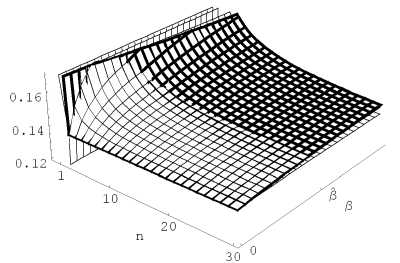Welfare, small σ

Figure 12: Home welfare, CBC and n∏ for small σ.
When labor market exhibits significant monopoly distortions, labor demand elasticity
is positively associated with monetary conservatism. However, for some small level of
CBC, the elasticity of labor demand may be higher under a NMP regime than in a MU.
This result is in contrast with Cavallari (2004) where a move to a MU always increases
labor demand elasticity (and hence welfare) when monopoly distortions are relevant.
Here as shown for instance in Figure 12 in presence of an ultra-conservative Foreign
CB, welfare under a NMP regime may exceed the MU one if the Home CB is relatively
populist. However, as we expected, a single monopoly union leads to the first best in both
regimes45 and, for a sufficiently high level of CBC, a MU becomes the second-best choice
in presence of more than a trade union.
8 Conclusions
The creation of a monetary union (MU) may alter the incentives to reform the labor
market. This issue is particularly relevant in Europe where labor markets are characterized
by the presence of large trade unions and the impact of domestic wages on the union-wide
inflation rate is diluted. Switching to a MU, the monetary policy of the central bank (CB)
is now addressed to union-wide targets instead of country-specific ones which implies a
new trade-off between inflation and employment in setting her optimal policy.
We have investigated the strategic impact of centralization in wage setting (CWS) and
CB conservatism (CBC) on economic performance by extending Lippi (2003) analysis so
as to introduce monopolistic competition and openness to trade in the product market.
We find in line with the case of a floating exchange rate regime (Cuciniello, 2007) that
the move towards higher level of CWS and CBC may increase employment and reduce
inflation in a MU if monopoly distortions in the labor market are significant. In such a case,
a conservative CB is willing to contract her money supply by causing more unemployment
45In the Appendix it is proved that welfare in a fully centralized wage bargaining system is always higher
in a MU than under a NMP regime.
29
More intriguing information
1. Ability grouping in the secondary school: attitudes of teachers of practically based subjects2. Opciones de política económica en el Perú 2011-2015
3. Getting the practical teaching element right: A guide for literacy, numeracy and ESOL teacher educators
4. Developing vocational practice in the jewelry sector through the incubation of a new ‘project-object’
5. Behavior-Based Early Language Development on a Humanoid Robot
6. The name is absent
7. Wettbewerbs- und Industriepolitik - EU-Integration als Dritter Weg?
8. AN ECONOMIC EVALUATION OF THE COLORADO RIVER BASIN SALINITY CONTROL PROGRAM
9. Work Rich, Time Poor? Time-Use of Women and Men in Ireland
10. The name is absent